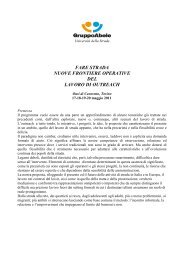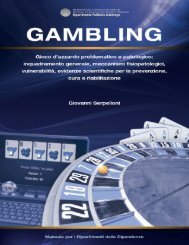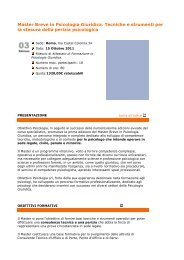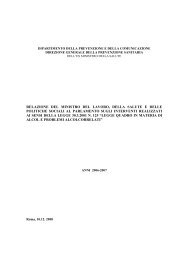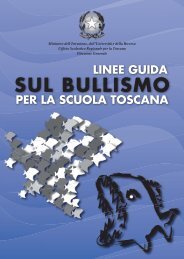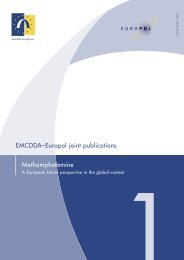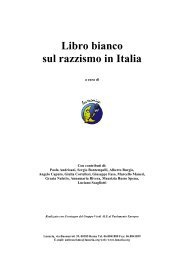Neuroscienze e dipendenze - Dipartimento per le politiche antidroga
Neuroscienze e dipendenze - Dipartimento per le politiche antidroga
Neuroscienze e dipendenze - Dipartimento per le politiche antidroga
You also want an ePaper? Increase the reach of your titles
YUMPU automatically turns print PDFs into web optimized ePapers that Google loves.
26 - E<strong>le</strong>menti di NEUROSCIENZE E DIPENDENZE<br />
5. Duncan E. et al, An fMRI study of the interaction of stress and cocaine cues on cocaine craving in cocaine-dependent men, The American<br />
Journal on Addictions 16: 174-182, 2007<br />
6. Fow<strong>le</strong>r J.S. et al, Low monoamine oxidase B in <strong>per</strong>ipheral organs in smokers. Proceedings of the National Academy of Sciences of the<br />
USA 100(20):11600-11605<br />
7. Fow<strong>le</strong>r J.S. et al., Imaging the addicted human brain, Science and practice <strong>per</strong>spectives, Apri<strong>le</strong> 2007<br />
8. Hariri A. R. et al., Serotonin transporter genetic variation and the response of the human amygda<strong>le</strong>, Science 297 (5580):400-403<br />
9. Kaufman J. N. et al, Cingulate hypoactivity in cocaine users during a GO-NOGO task as revea<strong>le</strong>d by event-related functional magnetic<br />
resonance imaging, Journal of Neuroscience 23(21):7839-7843<br />
10. King A.J., et all., Doing the right thing: a common neural circuit for appropriate vio<strong>le</strong>nt or compassionate behavior. Neuroimage 30 (2006)<br />
1069 – 1076<br />
11. Kufhal P. R. et al., Neural Responses to acute cocaine administration in the human brain detected by fMRI, Neuroimage 28(4):904-914,<br />
2005<br />
12. Kung H. F., et al., Radiopharmaceuticals for sing<strong>le</strong>-photon emission computed tomography brain imaging, Seminars in Nucelar Medicine<br />
33(1):2-13, 2003<br />
13. Lenroot R. K., Brain development in children and ado<strong>le</strong>scents: insights from anatomical magnetic resonance imaging, Neuroscience and<br />
biobehavioral Reviews 30: 718-729, 2006<br />
14. Leshner A.I., Addiction is a brain disease, and it matters, Science 278 (5335):45-47, 1997<br />
15. Li C. Y. et al., Genes and (common) pathways underlying drug addiction. Plos Comput Biol 4(1)e2.doi:10.1371/journal.pcbi.0040002,<br />
2008<br />
16. Liu X. et al, Smal<strong>le</strong>r volume of prefrontal lobe in polysubstance abusers: a magnetic resonance imaging study, Neuropsychopharmacology<br />
18(4):243-252, 1998, 1998<br />
17. Mattay V.S: et al., Catechol O-methyltransferase vah58-met genotype and individual variation in the brain response to amphetamine.<br />
Proceedings of the National Academy of Science of the USA 100(10):6186-6191, 2003<br />
18. Moore T. H. M. et al., Cannabis use and risk of psychotic or effective mental health outcomes: a systematic review, Lancet, 370: 319-<br />
328, luglio 2007<br />
19. Paquette V., Levesque J. Menseur B. et all. Change the mind and you change the brain : effect of cognitive –behavioral therapy on the<br />
neural correlates of spider phobia. Neuroimage, 2003 feb; 18 (2): 401-9<br />
20. Paus Tomás, Mapping brain maturation and cognitive development during ado<strong>le</strong>scence, Trends in cognitive sciences 9(2), febbraio 2005<br />
21. Stap<strong>le</strong>ton J.M. et al., Cerebral glucose utilization in polysubstance abuse, Neuropsychopharmacology 13(1):719-724, 1993<br />
22. Volkow N. et a., Changes in brain glucose metabolism in cocaine dependence and withdrawal, American Journal of Psychiatry<br />
148(5):621-626, 1991<br />
23. Volkow N. et al., The addicted human brain: insights from imaging studies, Journal of Clinical Investigation 111(10)1444-1451, 2003<br />
24. Risinger R. E. et al., Neural correlates of high and craving during cocaine self-administration using BOLD fMRI, Neuroimage 26(4):1097-<br />
1108, 2005<br />
25. Schlaepfer T.E. et al, Decreased frontal white-matter volume in chronic substance abuse, International Journal of Neuropsychopharmacology<br />
9(2):147-153, 2006<br />
26. Yücel M. et al., Understanding drug addiction: a neuropsychological <strong>per</strong>spective, Australian and New Zeland Journal of Psychiatry 41:957-<br />
968, 2007<br />
27. Wex<strong>le</strong>r B.E. et al., Functional magnetic resonance imaging of cocaine craving, American Journal of psychiatry 158(1):86-95, 2001<br />
28. Piazza PV; Le Moal ML Pathophysiological basis of vulnerability to drug abuse: ro<strong>le</strong> of an interaction between stress, glucocorticoids, and<br />
dopaminergic neurons. Annu Rev Pharmacol Toxicol,36():359-78 1996<br />
29. Andrews JA et al.: Parental influence on early ado<strong>le</strong>scent substance abuse. Journal of early ado<strong>le</strong>scence, 13:285- 310, 1993.<br />
30. Leshner AI. Vulnerability to addiction: new research opportunities. Am J Med Genet 2000 Oct 9;96(5):590-1.<br />
31. Black DW, Gabel J, Hansen J, Schlosser S. A doub<strong>le</strong>-blind comparison of fluvoxamine versus placebo in the treatment of compulsive buying<br />
disorder Ann Clin Psychiatry 2000 Dec;12(4):205-11.<br />
31. Hall GW, Carriero NJ, Takushi RY, Montoya ID, Preston KL, Gorelick DA. Pathological gambling among cocaine dependent outpatients Am<br />
J Psychiatry 2000 Jul;157(7):1127-33.<br />
32. Bechara, A., Nader, K. And Vander Kooy, D., 1998; A two-separate-motivational systems hypothesis of opioid addiction: Pharmacol Biochem<br />
Behav 59: 1-17<br />
33. Phillips, A. G., Ahn, S. and Howland, J. G., 2003. Amigdalar control of the mesocorticolimbic dopamine system: paral<strong>le</strong>l pathways to motivated<br />
behaviour. Neurosci Biobehav Rev 27: 543-554.<br />
34. White, N.M., 1996. Addictive drugs as reinforcers: multip<strong>le</strong> partial actions on memory systems. Addiction 91(7): 921-949.<br />
35. Tiffany, S.T., 1990. A cognitive model of drug urges and drug-use-behaviour. Ro<strong>le</strong> of automatic and nonautomatic processes. Psychological<br />
Review 97: 147-168.<br />
36. Grace, A.A.,1995. The tonic/phasic model of dopamine system regulation: its re<strong>le</strong>vance for understanding how stimulant abuse can alter<br />
basal ganglia function. Drug and Alcohol Dependence 37: 111-129.<br />
37. Adolphs,R., 2003. Cognitive neuroscience of human social behaviour. Nat Rev Neurosci 4: Mar 165-178.<br />
38. Stone, V.E., Cosmides, L., Tooby, J., Kroll, N. and Knight, R.T., 2002. Se<strong>le</strong>ctive impairment of reasoning about social exchange in a patient<br />
with bilateral limbic system damage. Proc Natl Acad Sci USA 99: 11531-11536.<br />
39. Frith, C.D., Friston, K., Lidd<strong>le</strong>, P.F. and Frackowiak, R.S., 1991. Wil<strong>le</strong>d action and prefrontal cortex in man: a study with PET. Proceedings of<br />
the Royal Society of London, Series B – Bioogical Sciences 244: 241-246.<br />
40. Zhu, J., 2004. Understanding volition. Philosophical Psychology 17: 247-273<br />
41. Spence, S.A., Hirsch, S. R., Brooks, D.J. and Grasby, P.M., 1998. Prefrontal cortex activity in peop<strong>le</strong> with schizophrenia and control subjects.<br />
Evidence from positron emission tomography for remission of “hypofrontality” with recovery from acute schizophrenia. Br J Psychiatry<br />
172: 316-323.<br />
42. Marshall, J.C., Halligan, P.W., Fink, G.R., Wade, D.T. and Frackowiak, R.S., 1997. The functional anatomy of a hysterical paralysis. Cognition<br />
64: B1-8.



